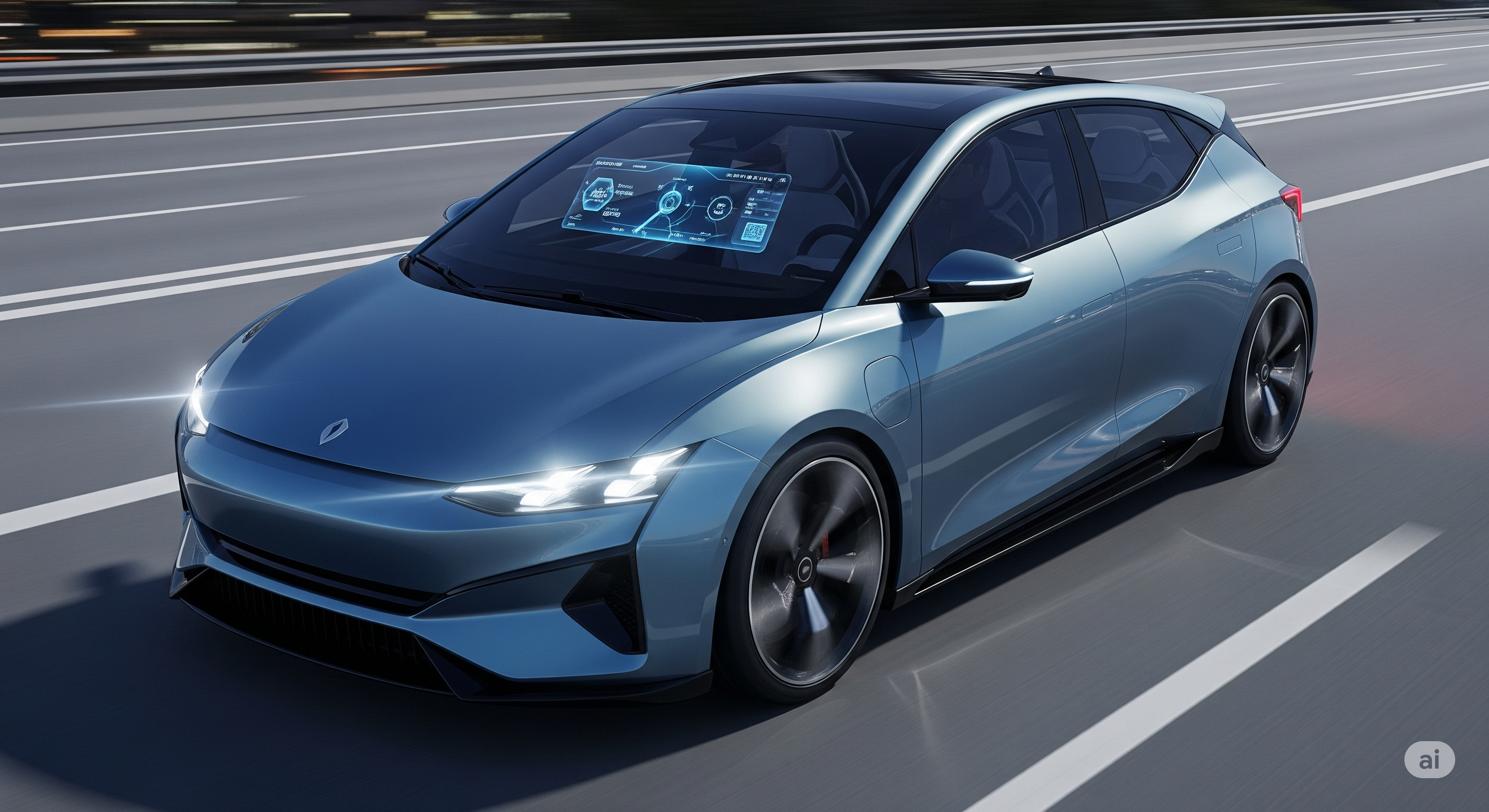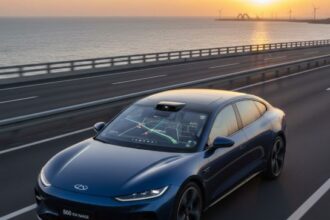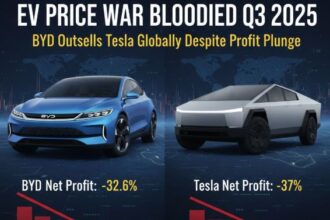Here is the image of a sleek, futuristic electric hatchback, highlighting its dynamic design and advanced technology:
The automotive landscape is undergoing a monumental transformation, and at the forefront of this revolution is the new electric hatchback concept recently unveiled by SAIC Motors and General Motors. This isn’t just another electric vehicle (EV); it’s a groundbreaking statement that redefines expectations for performance, range, and charging speed in the EV sector, offering a compelling vision for our electrified future.
Breaking Down the Breakthrough: Key Specifications Redefining EVs
The excitement surrounding this innovative EV is rooted in its truly remarkable specifications. Let’s delve into what makes each of these figures so pivotal for the future of electric mobility:
- Unprecedented 745-Mile Electric Range: This single figure addresses the long-standing “range anxiety” head-on. While many excellent EVs on the market today offer ranges between 250 and 400 miles, a reported 745-mile range dramatically expands the practical utility of an electric car. Imagine the freedom of embarking on extensive road trips with virtually no charging concerns, or the sheer convenience of needing to plug in only a handful of times a month for typical daily commutes. This extended range capability makes EVs a viable and compelling alternative for a much broader audience, including those residing in areas where public charging infrastructure is still developing. It signifies a profound shift, positioning EVs as capable, long-distance travelers on par with, or even exceeding, their gasoline-powered counterparts.
- Revolutionary 800-Volt Charging Architecture: 373 Miles in 10 Minutes: This is where cutting-edge technology truly shines. Most contemporary EVs operate on a 400-volt electrical system. By adopting an 800-volt architecture, this new hatchback facilitates significantly faster charging. The principle is simple yet powerful: doubling the voltage allows the same amount of power to be delivered with half the current. This reduction in current minimizes heat generation during charging and permits the use of thinner, lighter wiring within the vehicle, enhancing overall efficiency and reducing weight. More importantly, when connected to compatible high-power DC fast chargers, this system enables astonishingly rapid energy replenishment. The ability to add almost 400 miles of range in just 10 minutes fundamentally reshapes the EV ownership experience, making quick top-ups during a brief stop as convenient as refilling a traditional fuel tank. This advancement is crucial for accelerating mainstream EV adoption by eliminating one of the most common perceived inconveniences.
- Supercar-Level Performance: 644 Horsepower and a 3.8-Second 0-100 km/h Sprint: This electric hatchback obliterates the misconception that EVs are somehow less exciting to drive. With a formidable 644 horsepower delivered instantaneously by its electric motors, the acceleration is nothing short of exhilarating. A 0-100 km/h (0-62 mph) time of just 3.8 seconds positions this compact vehicle squarely in the realm of high-performance sports cars. This demonstrates that electric vehicles are not merely about environmental responsibility and efficiency; they can also offer an incredibly dynamic, responsive, and thrilling driving experience, challenging the long-held belief that internal combustion engines are superior for automotive enthusiasts.
- Pioneering Battery Density: 350 Wh/kg: “Wh/kg” (Watt-hours per kilogram) is a critical metric for battery technology, indicating how much energy a battery can store relative to its weight. A density of 350 Wh/kg is exceptionally high and represents a significant leap forward. To provide context, the energy density of most mainstream EV batteries currently ranges from approximately 160 to 250 Wh/kg. Even the highly regarded BYD Blade battery and the standard range battery in a Tesla Model Y have lower energy densities. This superior density means that more energy can be packed into a smaller and lighter battery pack, directly contributing to the vehicle’s extended range without encroaching on passenger or cargo space, or adding unnecessary weight. It’s a testament to continuous advancements in battery chemistry, cell design, and packaging efficiency, pushing the boundaries of lithium-ion technology and hinting at the potential for next-generation solutions like solid-state batteries.
- Intelligent Design: Compact Size, Massive Capability: In an era where larger vehicles often dominate, this new SAIC-GM offering embraces the versatility of a compact hatchback. Similar in dimensions to a BYD Dolphin at roughly 4 meters long, its size makes it ideal for navigating bustling urban environments, maneuvering into tight parking spaces, and offering practical everyday usability. The successful integration of such potent performance and groundbreaking range within a compact footprint is a remarkable engineering achievement. It signals that future EVs will not demand a compromise between practicality, cutting-edge technology, and exhilarating performance.
Broader Impact: Shaping the Future of Mobility
The implications of a vehicle boasting such advanced capabilities extend far beyond its immediate market appeal. As the video rightly points out, such high-performance and efficient electric vehicles are poised to become the standard by 2035. This accelerated trajectory of EV development strongly suggests a future where the long-reigning internal combustion engine may indeed transition into obsolescence for mainstream transportation. The rapid, continuous improvements in battery technology, the expansion of robust charging infrastructure, and advancements in manufacturing processes are collectively driving this transition at a pace that many once deemed impossible.
This concept car also holds strategic importance for Buick, particularly in the immensely significant Chinese market. Buick has faced considerable challenges in China recently, a nation that not only stands as the world’s largest automotive market but also leads the global charge in new energy vehicle adoption. By introducing such a technologically sophisticated and highly appealing EV concept, Buick aims to re-energize its brand image and capture a more substantial share of this intensely competitive yet highly lucrative segment. The development of this concept by PATAC Design, the joint operation between SAIC and GM, underscores a renewed and focused commitment to innovation specifically tailored for the discerning Chinese consumer.
From Vision to Reality: The Path Forward
While the SAIC-GM electric hatchback currently exists as a concept, the overwhelming enthusiasm surrounding its debut highlights the industry’s and the public’s eagerness for such transformative advancements. The fervent hope is that this concept will transition seamlessly into a production model, making these incredible specifications a tangible reality for consumers worldwide. The journey from a conceptual design to widespread mass production is complex and involves significant hurdles, including scaling up battery manufacturing to meet immense demand, refining intricate production processes, establishing resilient and ethical supply chains for critical materials, and ensuring cost-effectiveness to facilitate broad market adoption. Nevertheless, the relentless and rapid progress witnessed throughout the entire EV industry suggests that these challenges are increasingly surmountable.
This groundbreaking electric hatchback is far more than just a new car; it is a potent symbol of the electric revolution’s unstoppable momentum. It unequivocally demonstrates that electric vehicles can offer extended range, exhilarating performance, and unparalleled charging convenience, all while being packaged in a practical and aesthetically pleasing form. The future of personal mobility is not just on the horizon; it’s here, and it promises an electrifying ride.





